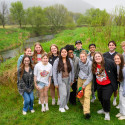Who Knew?

Q. How does a person who is disabled and/or in a wheelchair get through the heavy double doors that shut during a fire drill?
A. Although you may be surprised by the answer, it’s something that safety officials have been studying for a number of years. In case of fire or other emergencies, people in wheelchairs and others with disabilities should go to a room near the stairs and away from any obvious harm. Preferably the room should have a window and a telephone, says Marcia Carlson, a facilities planning specialist. Then they – or with the assistance of a staff member ideally, or a student – should telephone 911 to let the police and fire workers know where they are. The problem with those heavy fire doors is that stairways often are located on the other side, presenting another possible problem to disabled persons.
“There’s a lot of self-responsibility” needed on the part of a person with a disability, says Carlson, who uses a wheelchair. “You should figure out for yourself ahead of time what you should do,” she says.
For more details and updates on evacuation procedures, visit: http://wiscinfo.doit.wisc.edu/evacuation/.
Q. Where is the best place to go when a fire alarm or other emergency breaks out in a university building?
A. A. The most important place NOT to go is into a bathroom. That’s right. Although rest rooms may seem like safe places, especially in the case of a fire, they’re actually danger zones.
“Rest rooms have negative pressure, which means that air is sucked into the room and vented outside,” Carlson says. “In a fire or chemical spill, smoke or chemical fumes will be pulled into a rest room, potentially harming or killing anyone who is in the room.”
And if you see any notices still posted that instruct people to head to rest rooms in case of emergency, take them down, Carlson says. “In the distant past, well-intended but uninformed person(s) determined that people with disabilities should be directed to rest rooms in times of emergencies,” Carlson writes in a recent memo. Most notices were removed about five years ago, but a few remain.
People with disabilities should follow the instructions listed in the first item in this column, at least until other instructions are developed, Carlson says. “Because of the nature of our buildings, you can have hundreds of people in the building who have never been there before, so you must have a much more sophisticated process” for clearing large buildings, Carlson says. A campus group has been developing new procedures; more information should be available soon, she says.
Send your question to Who Knew? c/o Wisconsin Week, 19 Bascom Hall; or e-mail: wisweek@news.wisc.edu.




